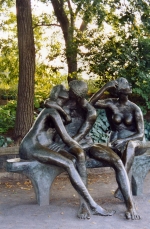Lea Vivot
Le banc des amoureux
1976
Presentation of the artwork
This bronze sculpture presents three figures sitting on a bench. A nude couple seem to be absorbed in the intimacy naturally created around them, whereas a third figure, dressed in a skirt and averting her gaze, projects boredom and solitude. On the bench, in graffiti, are sentences about love by famous people, such as Menachem Begin, Indira Gandhi, and Mother Teresa: “Se souvenir chaque jour que nous sommes tous frères,” “Love is the rhythm of life,” “Amor con la passion para siempre,” and so on.These larger-than-life figures are portrayed in a classic style that contrasts with the sculpture’s rather provocative theme. Sitting atop a small hill in front of the water lily pond in the perennials garden, the sculpture has aroused various reactions, ranging from sympathy to surprise. The erotic – some have said obscene – scene of the couple is imbued with a freedom, naiveté, and joie de vivre that is, in a way, shattered by the third figure symbolizing rejection and isolation.
In her first sculpture presented in North America, Vivot began her exploration of the theme of family that was to be predominant in her art production. Indeed, one could determine retrospectively that Le banc des amoureux represents the first step – that of love and seduction – in the formation of the family that Vivot’s sculptures portrayed.
Associated events
Le banc des amoureux was first briefly on display in Toronto in 1979, before being installed in front of the Montréal Museum of Fine Art. When businessman Abraham Hirschfeld purchased the artwork in 1985 for the lobby of a hotel, he commissioned a bronze reproduction as a gift to the Ville de Montréal and Montréalers. In this way, Hirschfeld was showing his gratitude to the city that was his first home in North America in the early 1950s. The sculpture was moved to its permanent site, the Botanical Garden, in September 1987.
Lea Vivot
Lea Vivot, who lives in Ontario, was born in Czechoslovakia. She studied at the Ontario College of Art in Toronto, the Academia di Brera in Milan, and the Art Students League of New York. Her sculptures, most of them figurative bronzes, offer a reflection on family and human relations. Two of her most important works of public art are on display in Toronto: Endless Bench is at the Hospital for Sick Children, and Joy of Life is in front of St. Joseph’s Health Centre.






